I make no apology for the fact that both past and present tense are used in this piece; nor for the fact that both the imperial and metric measurement systems are used. I was raised on the imperial and it is these measurements which I continue to use in this piece.
Mention the Australian outback to most people, be they from other nations or Australia and often visions of vast, barren deserts, miles upon miles of virtually nothing except a bush here and maybe a tree there and plenty of red bulldust, are conjured up.
Overall not an attractive picture, so most would think.

Old petrol bowser and pump on a station in Qld.
How wrong can some people be.
I was born in Adelaide, capital of South Australia and raised on a sheep station in the north eastern pastoral district of that state. The station is 115,000 acres, which is small compared with other stations further up and out. Our livelihood depended on Merino sheep for their wool and a few head of cattle. The land, which is very barren, is comprised of such vegetation as salt and blue bush, mulga and gum trees, among others. We average less than seven inches of rain per annum so cannot rely on cropping. Ours is amongst the first of the ‘big’ sheep stations heading north east of Adelaide.
Peterborough is the nearest town, being 32 miles away. Along with my three older brothers and our cousins, I was educated, until the ripe old age of 11, by School of the Air and correspondence school.
There were times when we actually did have enough rain to isolate us completely but with today’s technology this no longer happens. In those days (and I am only going back 30 or so years), we had our own generator providing us with 32 volt power, a telephone connected to a ‘party line’, mail once a week and groceries monthly. The wonderful Royal Flying Doctor Service provided our medical services in emergencies.
My brother and his family are living on and managing the station now. With improved roads, transport and technology my niece and nephew were able to attend the local primary school in Peterborough, rather than relying on the School of the Air. Both then followed the lead of the generations before them and attended boarding school in Adelaide.
As can be gathered from the information above, rain water is very scarce. While all (or most) stations have several large concrete tanks, dam water is used for personal bathing, washing and dish washing. The water looks dreadful, like wishy washy mud, but to many, it is a real novelty to wash and swim in. We also used to swim in the dams when they were full enough; usually they did not have enough water in them in which to swim. But there were the very rare occasions when water was plentiful, thereby allowing us to swim in the dams and even in the creek, both of which were a lot of fun. When swimming in the dams you just had to be careful not to be nipped by a yabby (similar to a crayfish or lobster and just as tasty). The other positives about swimming out there – no chlorination, no salt usually and no pullution. Just good pure water. A good deal of Australia’s outback water is supplied by huge artesian basins.
While kangaroos are a dearly loved part of the Australian fauna, they, along with rabbits and foxes, are also a terrible menace in the outback. Our station is surrounded by a supposedly dingo-proof fence. However, it seems no-one told the kangaroos about this as they cause more damage to the fence than anything else does. In fact, dingoes and wild dogs are plentiful further up north and rarely venture as far south as our station. They rip the stock to pieces – not to eat – just for the fun or it. Rabbits, kangaroos and other pests eat the spear grass and general vegetation, what there is of it, which is food for our stock.
Despite the above, as children we often rescued orphaned animals, including ‘joeys’ (baby kangaroos), emus, the odd kids (baby goats as some would know) lambs and calves. We also kept a carpet python as a ‘pet’ at one stage. All were released into the wild once old and strong enough.
Entertainment was a little different out there. Travelling over one hundred miles for any kind of social occasion was and still is very much the norm. If you were not prepared to travel – take a ‘road trip’ you didn’t really have a social life. I now live in the city and dislike driving in the suburbs intensely – too much traffic, too many pedestrians, traffic lights, freeways – no thanks. And I won’t go near the CBD. But put me on a country road and I can drive forever and love it. ‘Local’ towns held annual horse racing carnivals where the emphasis seemed more on local gossip, ‘high’ fashion and of course, drinking, than on the races themselves. Races? What races? We actually had race horses at one stage, but that was well before my time.
Up to the age of 11 my only real play-mate was my youngest brother, until we were sent away to different boarding schools. I also had a cousin – her father and my father were brothers and co-managed the stations for many years.
We all learned to ride horses and motor bikes and to drive cars (on the station only – NEVER outside the boundary) almost before we could crawl. That just seemed to be a part of life out there and I presume it still is on many remote properties.
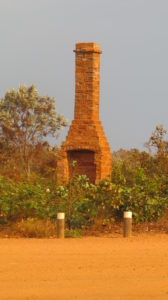
Old chimney stack. Rest of the building long gone. These are found throughout the rural and remote areas of the nation. What a story they could probably tell…
At times we were almost completely self-sufficient; raising our own chickens; milking our own cows and also making cheese and we had our own sources of lamb and mutton. Also vegetables and fruit when we had sufficient rains for them to grow. In the very early days we also produced bread from our own ovens. In those days, we were fortunate enough to have an excellent cook, along with governesses and a ‘cow-boy’. Those days are long gone now and we no longer produce any of the above apart from the meat and fruit and veges on occasion. While parts of the sprawling homestead have been modernised for practicality, the bread ovens have been preserved, along with our old milk-separating cellar, although neither is used.
Like most stations, we have a couple of ‘outstations’. In better years one of these held a family of about fifteen children; the other has been empty as long as I can remember. Now both stand empty.
The homestead itself is typical of many country homesteads, with huge rooms, very thick stone walls, completely surrounded by wide verandahs, huge open fireplaces and very high ceilings. This building, the engine room, slaughter house, shearers’ quarters, shearing shed, stables (no longer in existence) and assorted other buildings, resemble a small village.
And then there are the snakes and other reptiles and ‘creepy-crawlies’. The worst and most venomous snake is the Common Brown but we also have had the occasional visit from the King Brown, which lives further north. Another common species is the afore-mentioned Carpet Python, which is harmless. As for spiders, the harmless Huntsman is easily the most common and they can grow to be enormous. I am afraid that I am very much an arachnophobic and have suffered from this fear since childhood. I used to try to overcome this for the sakes of my daughters – but that didn’t work – they are both worse than I am. We also have the Redback spider, which is a cousin to the Funnelweb (which we do not have) but not as venomous. But you don’t want to be bitten by the Redback either.
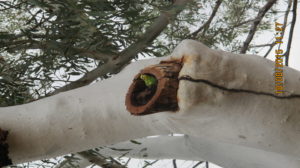
Budgerigars (budgies) poking their heads out of their front door to say hello – or maybe to tell us to go away.
Among my childhood and teen memories on the station is one relating to a certain uncle (not blood relative) who lives on a nearby station and who owned and flew a Tiger Moth aeroplane. This uncle used to make a habit of flying low over our station and dropping bags of sweets attached to tiny parachutes, for us children. This occurred annually, after he had visited the Royal Adelaide Show. We used to love racing each other into the huge creek bed at the front of the homestead searching for those little parcels; a bit like an Easter egg hunt. We also had an airstrip, as did and do most stations, only ours has been overgrown by salt and blue bush and I think would cause an emergency if someone tried to land a plane on it. If I remember correctly, these airstrips were mainly for the use of the Royal Flying Doctor Service (RFDS) as well as the odd other plane – like our uncle’s.
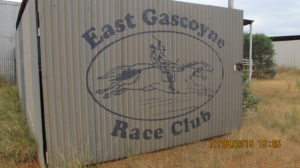
Sign for outback race club meeting. Western Australia.
The afore-mentioned creek could be quite dangerous, but very exciting, in heavy rains. It didn’t even have to be raining on the station; as long as there were heavy enough rains ‘upstream’, the chances were very hight of our creek coming down a ‘banker’ (meaning a usually bone dry creek suddenly filled to over-flowing with rushing water). I have only witnessed it once but would not have missed that. Imagine standing in a completely dry creek bed and suddenly hear an almighty roar – looking in that direction and seeing a huge bank of water, sometimes many feet deep, coming straight for you, taking all in its path. These ‘bankers’ have been known to drag fences, trees, windmills, junk, animals and anything else that gets in the way, as far as the creek travels. We have found items on stations over 200 miles away – and other items have disappeared forever.

Very dry lake bed…middle of Qld.
There really is just so much more to the magnificent Australian outback than has been mentioned here. To the eye of the uninitiated, it probably still is and always will be a vast, barren, boring, unending desert with very little, if anything, to offer – especially compared with mountains (we have those in the outback too), lush green pastures, rivers and waterfalls, flowers and other flora and fauna…yes, I concede that the outback could well be considered ‘ugly’.
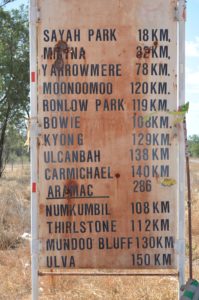
Just an idea of what the distances in our outback are like.
But it is not. To me, the outback is absolutely spectacular.
It really is beautiful if one bothers to take the time to really look and appreciate the beauty. You do not need a vivid imagination to really see the beauty out there. The colours of the hills and valleys at dawn and sunset and after a rain – even before a rain – are spectacular in themselves. I have seen many paintings of different settings in the outback – they cannot be imagined, they are real, just as are those of snow-capped mountains, waterfalls, rivers and forests.
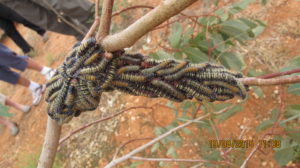
Outback worms….hmmm….
The fauna of the outback is as impressive as that of the lusher areas, too. As previously mentioned kangaroos abound out there – but not koalas. These gorgeous creatures are fussy eaters in that, while Australia has numerous types of eucalyptus trees, the koala will only eat the leaf of one species and this is found in certain areas of the nation, not all over. Other fauna includes hundreds of different sorts of reptiles, along with many other creatures, some harmful, others not. Emus, eagles, eaglehawks, galahs, sulphur-crested cockatoos, rosellas, cockatiels, wild canaries, budgerigars to name just a few. There are also hundreds of species of small ground-living birdlife.
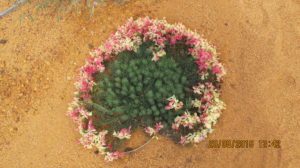
The spectacular Wreath Flower – one of our beautiful wildflowers.
Like every nation Australia has a huge amount of features of interest for the tourist and locals alike, but I just feel that the outback, which really does have just so much to offer, is so often overlooked. It is not even acknowledged by many city folk – or if it is, from what I have heard, it is very negative, in our own nation which I think is so very sad.
So this is my little effort to help acknowledge and salute it, as truly deserved.
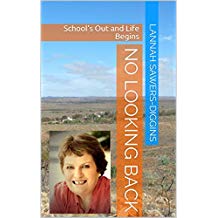
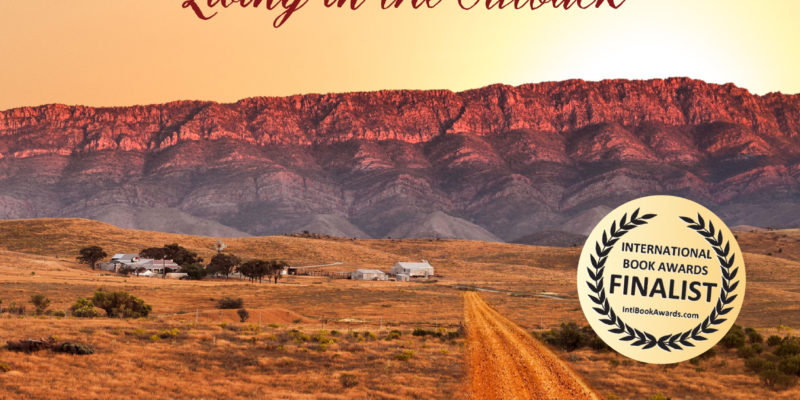












2 Comments
Lannah
We think about you so much and eagerly await the next phase, I was so happy to get the latest blog, I’m laying down and reading your latest out aloud to Lucy and we are both hanging on your every word, I could feel your passion for this country and especially your life as a child in just this short story, I filled in gaps by attempting to explain to Lucy some of the descriptive, so she could get even a small picture or vision of what it must have been like, and how in comparison the kids of the suburbs and cities are so incredibly vastly different, sges an old soul my girl, and even though she cant ever know what the fun and the hardship of the land was like, she yearns to learn, so as your blog and the words came to an end of the last paragraph,I suddenly felt overcome with emotion for the feeling you must have of an end to a must loved era in a lot of respects and my tears just started flowing, Lucy notices says ‘ oh Mum, don’t cry, it’s ok
and when my salty water stopped, I told her, I realise even more than ever, how important this is, to Lannah, to Australia and to the youth now and future generations, that it’s history and the families that built that be shared, talked about and preserved forever..
Thank you..talk soon..call me if you find time away from your computer in your downtime(if you get any lol)snort xx
Trace n Lucy xxx
Hi Trace n Lucy,
Thank you so much for this and for your email. My mobile is still playing up but will get hold of Steve ASAP and arrange to meet up with you both soon. Really looking forward to hearing your ideas. You have my writing and feelings perfectly – you seem to know exactly how I have felt and still do. I am hoping that this part will be an experience of a life time for Lucy. Really looking forward to working with you both. You are still acting as Lucy’s manager? Where are you living now?
Thanks again. Chat soon and will organise that meeting. What days are best for you two?
X Lannah